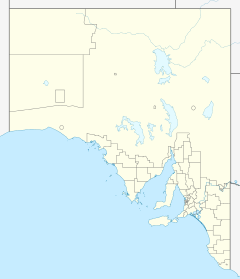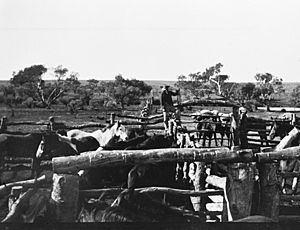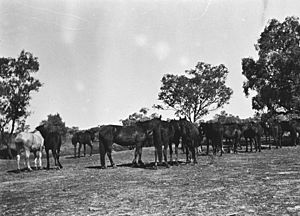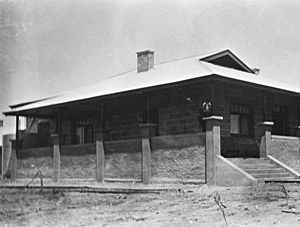Macumba Station facts for kids
Macumba Station, often called Macumba, is a very large pastoral lease in South Australia. It works as a cattle station, which means it's a huge farm where cattle are raised.
What is Macumba Station?
Macumba Station is located about 39 kilometres (24 miles) north-east of Oodnadatta. It's also about 201 kilometres (125 miles) east of Marla in South Australia.
How Big is Macumba Station?
This station is enormous! It covers an area of 11,063 square kilometres (4,271 square miles). To give you an idea, that's bigger than some small countries! It's the third largest station in South Australia. Only Anna Creek station and Innamincka Station are bigger.
Who Owns Macumba Station?
For a long time, Macumba was owned by a famous pastoral company called S. Kidman & Co. But in 2016, a new company bought it. This company is called Australian Outback Beef. It's owned by Gina Rinehart (who owns two-thirds of it) and a Chinese company called Shanghai CRED (which owns the other third).
What is the Land Like at Macumba?
Macumba Station has many different types of land. You can find sandhills, woodlands with mulga trees, and areas with redgum trees along watercourses. There are also parts that are desert or flat, stony plains called gibber plains.
Water Sources at Macumba
Several creeks flow through the property, including the Macumba River, Stevenson Creek, and Alberga Creek. These creeks have waterholes that often stay full, even when it's dry. One special water source is Willow Bore. This well was dug a long time ago, before 1892. It can provide 20,000 litres (4,400 imperial gallons) of water every day. That's enough water to support 2,000 cattle!
History of Macumba Station
Macumba Station has a long and interesting history, going back to before 1883.
Early Days and Challenges
In 1883, the area around Macumba was flooded. All the waterholes and creeks were completely full. A year later, in 1884, a man named Millard got lost in the desert on the station. He found the Australian Overland Telegraph Line, which was a very important communication line. To get help, he damaged a telegraph pole and cut the wire. This caused the telegraph line to stop working for several days. Sadly, when repair crews found the broken line, they also found Millard's body and his two horses.
In 1887, the station was owned by Messrs Chambers and Polhill. They even ran a store and a mail service from Macumba to places like Peake and Alice Springs. The original Macumba Station had been left because of frequent floods.
Changes in Ownership and Droughts
In the late 1880s, Joseph Albert Breaden managed the station. Later, in December 1888, the acting manager, George Bennet, and his son Albert died at the station. They were working with cattle in very hot weather.
Alexander W. T. Grant-Thorold and Henry L'Estrange, who were partners, bought Macumba before 1889. They brought 500 bullocks to the station. Over the next few years, they sold many cattle, including 1,000 in 1890 and 2,500 in 1891.
In 1893, the partnership ended, and Macumba was sold to John Waterstion. He also bought two other properties and 15,000 cattle. At this time, the properties were suffering from a long drought that lasted from 1892 to 1893. It's thought that Macumba alone lost 1,000 cattle because of thirst when all the waterholes dried up.
Floods and New Owners
In 1903, Macumba was flooded again when the Stevenson Creek rose quickly after heavy rain. Some people who were looking for gold were stuck for four days, waiting for the water to go down so they could cross the creek.
W. R. Cave took over Macumba before 1905. The station manager at that time was Mr. Smart.
Sidney Kidman Buys Macumba
A very famous pastoralist, Sidney Kidman, bought Macumba in 1905. He started moving horses from the property to sell them. Kidman visited the station in December 1905 and found it in "splendid condition."
In 1908, huge floods covered a large area, including parts of Macumba and its neighbour, Dalhousie Station. This happened after very heavy rains.
More Water and Challenges
In 1909, a second bore was dug at the station. This well found a great supply of artesian water at a depth of 650 feet (198 metres). It could provide 320,000 litres (70,000 imperial gallons) of water every day! By 1917, Macumba was known as one of the best-watered stations in the north.
The area faced a drought for three years, from 1928 to 1931. When the rains finally came in 1931, there were few cattle left. But there were also fewer vermin like rabbits and wild dogs. Even after good rains, the summer of 1932 was very hot, with an average temperature of 44 degrees Celsius (111 degrees Fahrenheit) for 50 days.
Recent Floods and Droughts
Severe floods hit Central Australia in early 1939. A temporary bridge over Stevenson Creek was washed away, and railway services were stopped for weeks. Telegraph poles fell, and a crossing at Alberga Creek was destroyed.
After World War II, R. M. Williams, a famous Australian, worked at Macumba. He transported wild horses (brumbies) to use in rodeos.
More floods hit the station in 1950 when 7 inches (178 millimetres) of rain fell in just 48 hours. The creek near the homestead became 0.5 miles (0.8 kilometres) wide, and some livestock were lost in the floodwaters.
Macumba had almost no rain for 14 months until June 2004. Then, it received 48 millimetres (1.9 inches) of rain over 10 days. The land started to grow fresh green grass, which helped the cattle. Eddie Nunn was the manager of Macumba in 2004.
In 2008, Macumba had to remove all its cattle because of a very bad and long drought.
The land that makes up Macumba Station was officially named 'Macumba' by the South Australian government on April 26, 2013.





